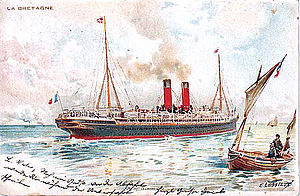SS La Bretagne
 SS La Bretagne in her post-1895 configuration
| |
| History | |
|---|---|
| Name | SS La Bretagne |
| Namesake | The former French province of Brittany (in French, Bretagne) |
| Owner | Compagnie Générale Transatlantique |
| Builder |
|
| Cost | $1,700,000 (about $58 million today) |
| Launched | 9 September 1885 |
| Maiden voyage | Le Havre–New York, 14 August 1886 |
| Fate | Sold for scrap, December 1923; grounded on way to scrapper |
| General characteristics | |
| Tonnage | 7,112 GRT |
| Length | 150.99 m (495 ft 4 in) LBP |
| Beam | 15.78 m (51 ft 9 in) |
| Depth of hold | 10.16 m (33 ft 4 in) |
| Propulsion |
|
| Speed | 17 knots (31 km/h) |
| Capacity |
|
| Notes |
|
SS La Bretagne was an
Design and construction
In March 1885, Compagnie Générale Transatlantique (CGT), announced the building of four new steamers for the Le Havre–New York route at the company's Penhoët ship yard. The similarly sized steamers, La Champagne, La Bourgogne, La Bretagne, and La Gascogne, were built under a French government subsidy law that provided that the ships could be taken over in a time of war. CGT also announced that noted French designer Jules Allard would decorate the four ships.[1]

La Bretagne was
CGT career
La Bretagne began her maiden voyage from Le Havre to New York on 14 August 1886,[2] and arrived on 22 August after a storm-tossed voyage carrying 281 passengers.[4] In April 1891, Pyotr Ilyich Tchaikovsky sailed to New York on the liner, for his one trip to the United States.[5] In June 1891, a westbound passage was marred when a drunken man flung his five-year-old son overboard in mid ocean. The man was seized and straitjacketed while a boat was launched in an unsuccessful attempt to save the boy.[6]
In the last quarter of 1892, La Bretagne seemed to be jinxed. In September, a

The success of upgraded engines on the liner La Normandie in 1894 prompted CGT to make similar changes on several older liners, including La Bretagne. In 1895, her triple-expansion engines were upgraded to quadruple-expansion engines, and her four barquentine-rigged masts were removed and replaced with two pole masts. At the same time, her third-class passenger capacity was nearly tripled, going from 600 to 1,500 passengers.[7]
In April 1898,
On 18 May 1899, a fire was discovered in the
La Bretagne's career was not marked entirely by misfortune. On her August 1902 crossing, a group of about 30 first-cabin passengers formed a vegetarian society, which they called "La Société des Legumineux", that gave the
Later career
In 1912, the newly reorganized Compagnie de Navigation Sud-Atlantique purchased a number of second-hand ships—including La Bretagne—for its relaunch of South American service from France.[18] La Bretagne sailed on the South American service through 1923, the last four years under the name of Alesia. In December 1923, Alesia was sold to a Dutch firm for scrapping. While on her way to the shipbreaker, Alesia's tow line parted and the ship ran aground on the island of Texel, becoming a total loss.[2]
Notes
- ^ "Four new French steamers" (PDF). The New York Times. 25 March 1885. p. 8. Retrieved 2 July 2008.
- ^ a b c d Bonsor, p. 656–57.
- ^ 1634–1699: McCusker, J. J. (1997). How Much Is That in Real Money? A Historical Price Index for Use as a Deflator of Money Values in the Economy of the United States: Addenda et Corrigenda (PDF). American Antiquarian Society. 1700–1799: McCusker, J. J. (1992). How Much Is That in Real Money? A Historical Price Index for Use as a Deflator of Money Values in the Economy of the United States (PDF). American Antiquarian Society. 1800–present: Federal Reserve Bank of Minneapolis. "Consumer Price Index (estimate) 1800–". Retrieved February 29, 2024.
- ^ a b "Her maiden voyage" (PDF). The New York Times. 23 August 1886. p. 8. Retrieved 2 July 2008.
- ISBN 978-0-679-42006-4.
- ^ "Flung his little son overboard". Chicago Daily Tribune. 24 June 1891. p. 9.
- ^ a b Bonsor, p. 631.
- ^ "La Bretagne's passengers" (PDF). The New York Times. 19 September 1892. p. 9. Retrieved 2 July 2008.
- ^ a b "La Bretagne's hard luck" (PDF). The New York Times. 11 December 1892. p. 10. Retrieved 2 July 2008.
- ^ "Penned up on La Bretagne" (PDF). The New York Times. 6 December 1892. p. 2. Retrieved 2 July 2008.
- ^ "At work on La Bretagne" (PDF). The New York Times. 12 December 1892. p. 8. Retrieved 2 July 2008.
- ^ "Eleven mariners saved" (PDF). The New York Times. 4 April 1898. p. 7. Retrieved 2 July 2008. For details of the SS La Champagne incident, see Bonsor, p. 656.
- ^ "Big liner takes fire". Chicago Daily Tribune. 19 May 1899. p. 3.
- ^ "La Bretagne's injuries" (PDF). The New York Times. 20 May 1899. p. 2. Retrieved 2 July 2008.
- ^ "The Prinzess Alice aground in the bay" (PDF). The New York Times. 28 May 1909. p. 1. Retrieved 11 April 2008.
- ^ "Vegetarians worry a chef" (PDF). The New York Times. 4 August 1902. p. 1. Retrieved 2 July 2008.
- ^ "The new fall siyles here on La Bretagne" (PDF). The New York Times. 11 September 1905. p. 7. Retrieved 2 July 2008.
- ^ "Compagnie de Navigation Sud-Atlantique". The Ships List. 12 April 2006. Retrieved 2 July 2008.
References
- Bonsor, N. R. P. (1978) [1955]. North Atlantic Seaway, Volume 2 (Enlarged and completely revised ed.). OCLC 29930159.
